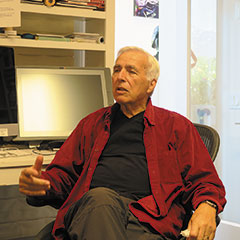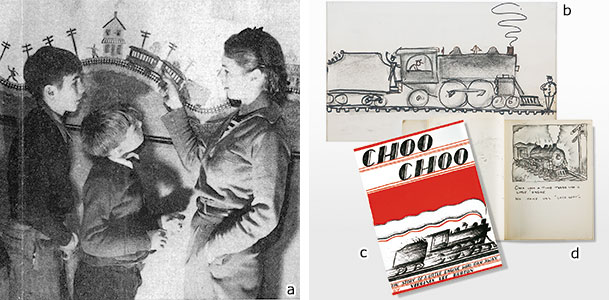ヴァージニア・リー・バートンのご長男 アリスティデス・デメトリアス氏にきく
2016/11/07

お母様のジニーさんはどんな方だったか教えてください。
彼女は、母親、慈愛に満ちた母として聖人のような人でした。朝4時から7時まで仕事をして、私たちに朝食を作り、2時まで仕事、それから家の用事をして夕食、そして8時に就寝しました。 そして、毎日散歩しました。 散歩にはいつも、そのとき飼っていた犬が一緒でした。 母は花が好きで、育つものは何でも好きでした。 素晴らしい人でした。 私と弟は母の一番のお気に入りになりたくて、母に「誰がいちばん好き?」と聞いたものです。母は私に「あなたは私がいちばん好きな長男」、 弟には「わたしがいちばん好きな次男」と、公平に答えました。 私たちはみんな笑いました。
あなたの1番好きな絵本は『いたずらきかんしゃちゅうちゅう』ですね。
私が一人っ子だった時は私が彼女の一番のお気に入りでした。 私の弟が生まれると、お気に入りが二人になりました。 彼女は素晴らしいお母さんでした。 本を書くこと、フォリーコーブ・デザイナーズの仕事、その他のこと。 彼女は友人に私たちのベビーシッターを頼みました。 そして友達はそのかわり絵を教えてと言いました。 それで彼女は絵を教え、友達の友達も来るようになりました。 1年もたたないうちにデザインを学びたいと言う女性たちのグループができました。 彼らの共通点は、3マイル(5キロ)以内に住んでいたことです。それで彼らは歩いてくることができました 。当時は景気が悪かったので車はありません。彼らは毎月、ジニーのデザインのレッスンに歩いてきました。
そこにはルールがありました。 ぜんぶ自分でやること。 生きているものか、生きていたものを題材にすること。 すべてのプロセスを自分自身でやるので、コピー機を使ったり誰かに頼んだりすることはできません。絵を描き、ブロックを彫り、プリントします。 ナプキンをプリントしたら縁に房飾りを付けます。これを全部自分たちでやります。 彼らはすぐ上手になり、5年のうちに、アメリカで最も読まれている雑誌、ライフ誌にとり上げられました。 小さな町でそんなことが起こったのです。1000人もいないレーンズビルの村で。母が信じたことは本当だったのです。アートは誰にも存在するのです。これはとてもアメリカ的でもあります。母はすべてにおいて、とてもアメリカ的です。それが成功した理由です。
ものを創り出すために重要視したことは何だったのでしょう?
第一に、好きなもの、目にしたもの、理解したものを大事にしたと思います。デザインするというのは、よく理解することで、そうでなければデザインはうまくいきません。だから、すべてにおいて愛と情熱が必要です。そのデザインの多くは、身のまわりにあるものです。それがボートであれ、花であれ、子どもであれ、身近にあります。ブロックを見れば、そのデザインがどこから来たのかわかります。母たちは、たしか、1938年に母の納屋で最初の全員の展覧会をしました。それからしばらくして、展示専用の場所ができました。
デザインするときに大切にしたことは何でしょう?
母にとって大切なことは、愛すること、十分に吸収すること、そうすれば、デザインするときの要素が見つかります。たとえば花の要素は、円に見えるかもしれない。花ではなく、円を見るというようなことが大切です。
そして、この二つを組み合わせなければなりません。別の言い方をすれば、花を抽象化しなければなりません。それがデザインです。二次元に置き換えて、そしてリノリウムの板に写し、彫って、プリントします。ローラーでペンキをつけて、布の上にプレス版をのせて、最初は、ご存知でしょう?彼らはプレスの上に実際に乗ったのです。ディプロマというテキスタイル・デザインの最後を見てください。彼らはジャンプしています。最初の印刷機は、本当に足だったのです。
ジニーは1964年に来日しました。その思い出を聞きましたか?
石井桃子さんと母は姉妹のように親しかった。母は英語、桃子は時々日本語でしたが、お互いに理解し合っていました。親しい友人というのは、独自の言語をもつものです。二人は理解し合っている親友でした。
たしか、冬に日本に行って大好きになりました。母は日本のものはすべて、デザインも好きでした。アメリカは若い国で、継承するものがありません。さらに我々はあらゆる地域から来ており、いまも我々が何者なのかを知ろうとしています。反対に日本では、強い伝統文化の感覚が引き継がれています。我々が知らないもの、つくりあげようとしているものです。しかし、良い面もあって、アメリカには世界のどこよりも自由があります。私が思うに、ジニーは誰もがアーティストになれるということを実証しました。
すべての人の内面にアートがあります。彼女が教えたのは、そのことです。それは、フォリーコーブ・デザイナーズや母が教えたことなどの多くの良い事柄のメタファーでした。もし私たちがこんな用語を使って話したら、母は、「どうでもいいわ、私たちはただの良いデザイナーです。インテリにしないで」というでしょう。彼女の感覚は完全でした。自由な精神と規律の両方をもっていたのです。母の父はニューイングランドの家系で、MITの学部長でした。そして、母の母は、最初のフラワーチャイルドでした。フラワーチルドレンといっても1960年代ではなく、その三世代も前に、祖母はダンスを踊ったりしていました。変わった人だったのです。だからジニーには両方のルーツがあります。
絵本のなかにジニーがいるようです。
母は、あらゆることに美を見出しました。小さなタンポポも、母の手にかかればバラになります。本に自然や花をたくさん描きました。絵本のなかの動物たちは元気いっぱいです。キャリコをご存知ですか?あれは、ジニーです。小さくてわんぱくで、何でもできて、みんなを守る。母は、母の本のなかにいます
1930~40年代の絵本、『ちゅうちゅう』ができた頃は、主人公は男の子でしたが。
彼女の絵本はどれも、何らかの解決があります。やればできる、母はそういう人でした。母の本がとても良いのは、なにかを肯定しているからでしょう。子どもたちが2年間あきずに毎晩読んでとせがむような本です。子どもが成長するときに、なにか素敵なことが起こりそうと思わせてくれます。大きな恐ろしいものが子どもを捕まえにくるといった昔話とは違います。
彼女がアメリカ的というのは、精神の自由ということでしょうか?
母はとても人間的で、アメリカ的といえると思います。母は、完璧な女性というより、完璧な人間です。よい心(soul)をもった人です。どの本にもそれが表れています。「私は良い人間で、毎日教会に行っています」ということではなく、もっとシンプルで、厳粛な意味で。母は牧師のように説教するのではなく、子どもたちに熱心に語りかけました。説教するのではなく、「なにが起こったかみてごらん」と語りかけます。すると子どもたちは「ぼくもやりたい!」と答えます。母は本当に奇跡のような人です。最初の本から、80年になるのですから。
完璧な人間なのですね
そうですね、母には大変な時期もありましたが、完璧な人間だと思います。ギリシャ神話のアトラスのように、大変なことがあっても文句をいわず、肩をすぼめて「やりましょう、まだできます」と答える。母はそういう人でした。
フォリーコーブに新しいスタジオをつくりました。
新しいスタジオをつくったのは、1950年代の後半か60年代の前半です。そこは美しい場所で、母はかもめと一緒に仕事をすることができました。ノートブックをいつも持ち歩いていました。
私の祖父母には3人子どもがいましたが、祖母に喘息があり、空気の乾燥した場所、ニューメキシコに移りました。そこで2、3年過ごし、MITの学部長をしていた祖父は夏になると汽車で家族を訪ねていました。それから家族はカーメルに移り、ジニーが14歳まで過ごしました。それから祖母が祖父の学生と恋におちて、家族はバラバラになりました。ジニーはカリフォルニアの山の方の町で4年過ごし、サンフランシスコの美術学校の奨学生となりました。母は、サンフランシスコ湾の対岸に住んでいたので、バスとフェリーとケーブルカーで通いました。
母は、描くことが大好きでした。でも、誰かをスケッチしているときに、その人に気付かれると、顔を背けられてしまいます。そこで、カメラで写真をとるみたいに早くスケッチできるようにしました。そしてボストンに行ってから、ボストン・トランスクリプトという新聞社でヴィジュアル・レポーターになりました。ニューヨークタイムスのアル・ハーシュフィールドがやっていたことをしたのです。現場に行き、記憶して、スケッチして、それを2時までに印刷用の絵にするのです。母の眼は素晴らしくて、カメラのフレームに収めるように記録できました。ものの見方を研究したのです。
ジニーはなんでも上達させることができました。デザインの才能が欲しくて、それを手に入れました。なんでも、やってのける気概がありました。スポンジのように、なにもかも熱心に学びました。驚くべき女性です。すべての女性のモデルになると思います。
インタビュー:内山さつき 田中厚子 岡部三知代
翻訳:田中智弥 田中厚子

a. 二人の息子アリスとマイクと話すバートン。
絵本の場面の線路を上り下りする列車、
ふざけまわっているカウボーイ、
穴を掘っているメアリー・アン、
そしてふりそそぐ太陽の光などが息子たちの
寝室の壁や天井を飾っていた。
(©1944『クリスチャン・サイエンス・モニター』)
b. 機関車と鉄道員 1964、東京子ども図書館所蔵
c. 『いたずらきかんしゃちゅうちゅう』 ©Aristides Burton Demetrios
d. スケッチブック 制作年不明、アリスティデス・デメトリアス蔵
An Interview with Aristides Demetrios
2016/11/07

Tell us your memories of your mother, Jinnee?
What was she like? What kind of person was she?
As a mother, she was a saint. She was very loving – she arranged her schedule to accommodate us. She worked from 4 to 7 in the morning, gave us breakfast, worked until 2 o’clock, then did the affairs of the house, prepared us supper, and went to bed at 8. She tried to walk everyday, usually accompanied by whatever dog we had. She loved her dogs and flowers; she loved anything that grew. She was fantastic. My brother and I both wanted to be the favorite one. She was diplomatic and said to me, “you are the best older son I ever had,” and said to my brother, “ you are the best younger son I ever had.” We all laughed.
Your favorite book is Choo Choo, right?
Because I was the only son, I was her favorite. When my brother was born, we had to split the favorite. She was a fantastic mother. She balanced writing the books, running the Folly Cove Designers, and teaching her friends how to draw. The first of those women was her friend who babysat us in return. Within a year, there were a group of women that lived within 3 miles that wanted to learn to design. This was the depression there were no cars, so they could walk to a monthly lesson that Jinnee gave about design.
She had standards. You had to do it all yourself, and the designs had to be something that was alive or lived. The whole process had to be done by them. Neither machine, nor anyone else could do it for them. They would draw the designs, turn them into print blocks, and then print them. They would print napkins that had fringed edges, they got so good at it that within five years they were in Life Magazine, the biggest magazine in the United States. This is coming from a tiny village, Lanesville, with no more than a 1000 people. What she believed in as true is that art exists in everybody, when you think of her and her ethos, it’s really American, and that’s why it’s so successful.
What did she consider to be important for design or creation?
It had to be something you loved, something that you looked at, something that you understood. Otherwise the design wouldn't work. There is passion and love in all of this; most of the designs are something that happened around them. Whether it was a boat, a flower, or a child. I can look at the blocks and tell you where they came from. The first exhibit of all the designers was in 1938, in Jinnee’s barn. Later, they were given a place of their own.
What was important for her in her designs?
In design you try to find the essence of something, you have to love it and absorb it. The essence of a flower is in a circle so you just see the circle and not the flower anymore.
You have to combine the two. In other words, you have to make an abstraction of the flower, and put that into two dimensions. Then you put that on a piece of linoleum and cut it out so that you get a print. You roll the paint on with a roller, put the print down on the cloth and press - they stood on the press - their first press was their feet.
Jinnee went to Japan in 1964.
Did you hear about her memories in Japan?
She was very close with her contact, Momoko Ishii; they were like sisters. My mother would talk in English and sometimes Momoko would talk in Japanese, but they understood each other, like best friends.
One winter, she went somewhere in central Japan, and loved it. She loved everything Japanese – she loved the designs. Comparatively, America is a young country; we don’t have the lineage that you do. Furthermore, we come from everywhere, and we are still trying to figure out whom we are. The Japanese have a stronger sense of culture, whereas we are not sure of ours, and we make it up all the time. However, there are some great things about that. There is more freedom here than anywhere else in the world, Jinnee proved that anyone can be an artist.
Which means, there is art in everyone and that was her lesson. It’s truly a metaphor for a lot of good things – the Folly Cove Designers and how she taught – but she would say, “that’s nonsense, we are just good designers,” and to not intellectualize her. Her instincts were perfect. She had the spirit and the discipline. Her father was from a long line of New Englanders, he was a dean at MIT, and my grandmother was a flower child. She was that, three generations ago, dancing and whatever out of this world. So Jinnee has both of those roots.
Her books always reflect herself.
She saw the beauty in anything. The way she wrote the books, the designs they have, a little dandelion - when she got through it - was a rose. She loved that, and had many books on nature, like flowers. All the animals in the books are spunky. Calico the Wonder Horse, that’s Jinnee, a little bit naughty but can do anything, save everybody. Her character is in all of the books.
If you were to take all children’s books during the 30s and 40s, when Choo Choo came out, most of the heroes were boys.
If you look at all her books, there is a solution to everything. That’s the way she was, an “I can do it” attitude. That’s why I think the books are so good, because it affirms something. The children want the books to be read every night for two years. Unlike other fairy tales, instead of the “big bad jungle” is going to get you, in her books, something wonderful is about to happen to the child as they grow up.
You said that she is very American, meaning that she is very free in sprit? She was also disciplined.
She is also very human, a complete human being who happened to be feminine. She is a good soul, and that quality is there in every one of her books. They are simple and grand, they won’t say, “I’m a good soul, I go to church everyday;” she doesn’t preach like a minister, but woos the children. She asks the children “Look what happened,” and they would answer, “I want to do it too!” She is a real miracle. It has gone on for 80 years since the first book.
She’s a perfect human being.
Yes, she is, though she had a rough time. Like the great myth about Atlas, the Greek god, she just shrugged her shoulders and said “bring it on, I can still do it.” It was incredible.
Do you know what year she got the new studio in Folly Cove?
She got the new studio in the late 50s or early 60s. It is a beautiful place. She could work with seagulls, and carried her notebook around all the time; it was wonderful.
My grandparents had three children, and when my grandmother developed respiratory problems, they moved to New Mexico because the air is dry. They spent two or three years there, and my grandfather would come in the summers on a train and they would be together. Then they moved to Carmel, where they stayed until Jinnee was 14. Then my grandmother fell in love with my grandfather’s student and left, and the family separated. Jinnee went to a town in the mountains of California and spent 4 years there. She won a scholarship to art school in San Francisco, and lived across the bay. She would take a bus, to the ferry, to the cable car.
She loved to draw. She found that if anybody detected that they were being watched and drawn, they turned their head away. So she learned to sketch quickly, like taking a picture with a camera. She could draw like that. When she went to Boston, she became the visual reporter for the Boston Transcript. She would do what Hirschfield use to do for the New York Times. She would go out, memorize, make a sketch, and draw it out so that it could be printed by 2 o’clock. She had a fantastic eye, just like stopping on a frame of a regular camera. She developed a special talent of how to organize how you see the subject.
Jinnee can develop anything, she wanted a talent for design - she got it. She had a marvelous mind. She was eager to learn everything, like a sponge. An amazing woman, she could be a model for all women.
Inteviewer: Satsuki Uchiyama Atsuko Tanaka Michiyo Okabe
Translation: Motomi Tanaka Atsuko Tanaka

a. Aris and Mike with their mother,
whose storybook scenes-a train
rolling down the tracks,
romping cowboys,
Mary Anne digging holes,
a beaming sun –decorated her sons’
bedroom walls and ceiling.
©1944 THE CHRISTIAN SCIENCE MONITOR
b. Untitled (Locomotives and railroad workers) 1964, Collection of Tokyo Children’s Library
c. “CHOO CHOO” ©Aristides Burton Demetrios
d. Sketchbook Undated, Collection of Aristides Demetrios